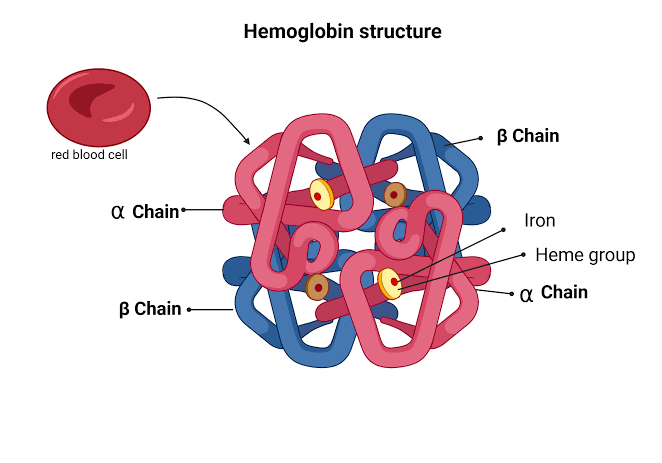
Structure and Role of the Heme Prosthetic Group
The heme prosthetic group is an essential component of both hemoglobin and myoglobin, responsible for their oxygen-binding capabilities. Structurally, it consists of a porphyrin ring system, which is a large, planar, and cyclic organic molecule made up of four pyrrole subunits linked by methine bridges. At the center of this ring lies an iron ion (Fe²⁺) that is coordinated to the four nitrogen atoms of the porphyrin ring. This iron ion can form two additional coordination bonds: one with a histidine residue from the protein (proximal histidine) and another with oxygen or other ligands at its sixth coordination site.
The primary role of the heme group is to bind oxygen reversibly. The Fe²⁺ in the heme allows for this reversible binding, enabling oxygen transport in hemoglobin and oxygen storage in myoglobin. Additionally, the heme group plays roles in electron transfer processes and enzymatic reactions in other heme-containing proteins.
Major Structural Features of Myoglobin
Myoglobin is a globular protein primarily found in muscle tissues where it facilitates oxygen storage and delivery. Its major structural features include:
- Single Polypeptide Chain: Myoglobin consists of 153 amino acids arranged into a single polypeptide chain.
- Eight Alpha-Helices: These helices are labeled A through H, connected by short non-helical loops.
- Heme Binding Pocket: The heme prosthetic group resides within a hydrophobic pocket formed by residues from helices E and F.
- Proximal Histidine (His F8): This residue directly coordinates with the iron atom in the heme group.
- Distal Histidine (His E7): This residue stabilizes bound oxygen via hydrogen bonding.
- Compact Globular Structure: Myoglobin has a highly compact tertiary structure that optimizes its function as an oxygen reservoir.
Major Hemoglobins Present in Adults and Fetuses
- Adult Hemoglobin (HbA):
- The predominant form is HbA1, composed of two alpha (α) chains and two beta (β) chains (α₂β₂).
- A minor form, HbA2, consists of two alpha chains and two delta (δ) chains (α₂δ₂).
- Fetal Hemoglobin (HbF):
- Composed of two alpha chains and two gamma (γ) chains (α₂γ₂).
Difference Between Normal Hemoglobin and Methemoglobin
- Normal Hemoglobin:
- Contains iron in its ferrous state (Fe²⁺) capable of binding oxygen reversibly.
- Methemoglobin:
- Contains iron oxidized to its ferric state (Fe³⁺) which cannot bind oxygen effectively.
- Methemoglobinemia occurs when methemoglobin levels are abnormally high, impairing oxygen delivery to tissues.
Site Where Carbon Monoxide Binds
Carbon monoxide (CO) binds to hemoglobin at the same site as oxygen—the distal side of the iron atom within the heme prosthetic group. CO has an affinity for hemoglobin approximately 240 times greater than that of oxygen, which makes it highly toxic as it prevents effective oxygen transport.
Subunit Composition Comparison: Fetal vs Adult Hemoglobin
- Fetal Hemoglobin (HbF):
- Composed of two alpha (α) subunits and two gamma (γ) subunits (α₂γ₂).
- Adult Hemoglobin (HbA):
- Composed predominantly of two alpha (α) subunits and two beta (β) subunits (α₂β₂).
Functional Significance of Fetal Hemoglobin Composition
The unique composition of fetal hemoglobin (HbF) provides it with a higher affinity for oxygen compared to adult hemoglobin (HbA). This higher affinity allows HbF to efficiently extract oxygen from maternal blood across the placenta even at lower partial pressures of oxygen. This adaptation ensures adequate oxygen supply to developing fetal tissues.
Distinction Between Homotropic and Heterotropic Effects
- Homotropic Effects:
- Occur when a ligand influences its own binding to a protein.
- Example: Oxygen binding to one subunit of hemoglobin increases the affinity for subsequent oxygen molecules due to cooperative interactions.
- Heterotropic Effects:
- Occur when different molecules or ions influence ligand binding.
- Example: Protons (H⁺), carbon dioxide (CO₂), or 2,3-bisphosphoglycerate (2,3-BPG) modulate hemoglobin’s affinity for oxygen by stabilizing either its Tense (T) or Relaxed (R) states.







